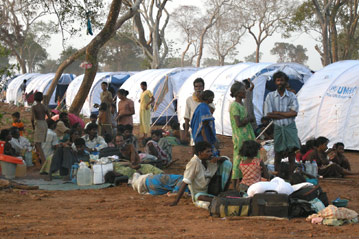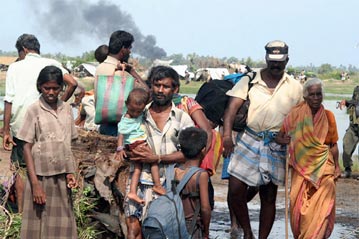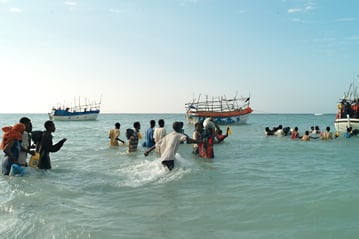Determined Zimbabweans flow into South Africa
Determined Zimbabweans flow into South Africa

BEIT BRIDGE CROSSING, South Africa, October 9 (UNHCR) - Each dusk the cat-and-mouse game begins: Zimbabweans cross the Limpopo River and slip through the fence into South Africa, while South African authorities patrol the border to intercept and fill their trucks with Zimbabweans who will be deported within hours.
In September, a typical month, some 7,300 Zimbabweans were deported just from Musina, the main South African town near the bridge over the Limpopo to Zimbabwe. From all of South Africa, more than 20,000 Zimbabweans accused of illegally entering South Africa are deported each month - probably including people caught repeatedly.
South Africa is facing a complex situation, with growing numbers of both economic migrants and asylum seekers arriving from many parts of Africa. Nearly a thousand people a month arrive across the bridge, South Africa's busiest border point, asking for asylum. These asylum seekers - mainly from the Democratic Republic of the Congo and the Horn of Africa - are issued with documents that allow them to continue on to Johannesburg, where they can enter a formal application for refugee status.
However, only one Zimbabwean in the last four months has requested asylum from South African immigration officials at the border. There are various explanations advanced: reluctance to request asylum when still so close to Zimbabwe, anxiety to reach their destination in the South African heartland, a lack of opportunity because they are deported so swiftly, or simply no desire to assume a status that means they cannot visit their homeland.
Substantial numbers of Zimbabweans do apply for asylum at other refugee offices in South Africa - about 19,000 last year. However, these Zimbabweans remain a relatively small percentage of the hundreds of thousands who annually enter the country. Those intercepted are only a portion of the undocumented Zimbabweans who get through the fence into South Africa.
"The situation in Zimbabwe is complex, as are the reasons for people leaving. We have to acknowledge the human rights dimension of recent developments in Zimbabwe. Some Zimbabweans do ask for asylum. Their numbers are significant in absolute terms. For the moment, however, they remain a small percentage of the very large number of Zimbabweans who are reportedly outside of their country," UN High Commissioner for Refugees António Guterres said in August.
Staff of the UN refugee agency regularly monitor the borders of Zimbabwe - not just in South Africa but also in Mozambique, Botswana and Zambia where other Zimbabweans head - to see why people are leaving and if they need protection. The economic pressures on those living in Zimbabwe, where shelves are nearly empty, are clear: the manager of the main supermarket in Musina reported the daily flood of shoppers from Zimbabwe in recent months generated sales equal to those normally seen in the pre-Christmas season.
Arriving Zimbabweans - mainly young men - say they have come to earn funds to support families who remain at home, where unemployment has been estimated at 80 percent. Many return home regularly - which is not permitted if they are refugees - and the number of Zimbabweans intercepted rises early in the year as they return from the holiday season with families.
There is clearly a humanitarian crisis when so many people feel compelled to leave their country. Although UNHCR's prime focus is on ensuring that those in need of protection from persecution have access to the asylum system, it has encouraged organizations helping needy Zimbabweans arriving in South Africa to provide humanitarian assistance.
UNHCR is also working with the government of South Africa to speed up the processing of applications for refugee status, a problem of capacity that has affected all asylum seekers. With some 140,000 applications from citizens of scores of countries still awaiting decisions, South Africa's Department of Home Affairs is hiring additional staff and improving procedures. Fortunately, the renewable temporary papers issued to all asylum seekers by the government mean they can remain in South Africa while they are awaiting a decision.
The number of people willing to cross the dangerous waters of the Limpopo - the rainy season that is just beginning increases the threat of crocodiles - indicates the depth of the problem facing Zimbabweans. The flow of migrants from Zimbabwe will end when it regains economic and social stability.
On the N1 National Highway leading south from the bridge named for mining magnate Alfred Beit to South Africa's industrial heartland around Johannesburg, police checkpoints intercept Zimbabweans who have evaded the first sweeps near the border. But authorities readily admit that those they take back to Zimbabwe in the morning are probably crossing again as night returns.
By Jack Redden
at the Beit Bridge crossing, South Africa








